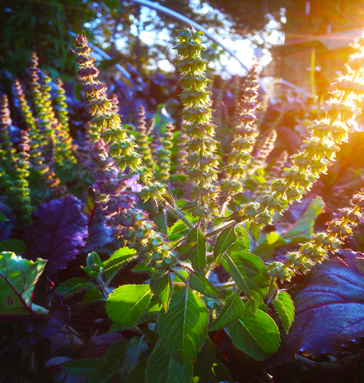Tulsi: "The Queen of Herbs" Our featured herb goes by several common names, "Holy Basil" and "Tulsi" being the most used. In Hindi, Tulsi means "the incomparable one"; its botanical name, Ocimum sanctum, translates to "Holy Basil." Ayurvedic practitioners refer to it as "The Queen of Herbs." In the same genus as culinary basils, Tulsi has the same basic cultural requirements, but in contrast to the tender annuals we use for pesto, if kept frost free, Tulsi will live many years as a small woody shrub. Full sun, good drainage, and warm days are pretty much all that you need to grow your own Tulsi; the plants are tougher than their cousins in both drought and heat. Traditionally grown in front of almost every home in India (depending on the household deity) there are several major varieties of Tulsi. Two main varieties of Ocimum sanctum are "Krishna," which is a purple-leafed plant, and "Rama," which is green. Both are used as a tonic, stress reliever, immune system booster, anti-inflammatory, digestive aid, and adaptogen. Both contain many beneficial antioxidants and have the same lovely, anise-like aroma and flavor. Make your own Tulsi Tea Tulsi is a great herb because you don't need to have anything "wrong" with you to benefit from its use, as it is a fantastic adaptogen as well as an uplifting and delicious tea. It is also a great herb because it is so easy to use; all you need to do is gather leaves from a plant and dry them, keep them in a sealed jar in a cool and dark area, and brew them the way you would brew any loose-leaf tea as often as you wish. The tea tastes good sweetened or not, warm or cold, and is just lovely with turmeric or cinnamon added. During the summer, nothing beats an glass of iced Tulsi tea sweetened with some agave syrup, if you ask me. Really gets a body motivated in the heat to get back out in the garden and sweat! This time of year, the days are cooling, the nights are chilling, and frost is around the corner. It is time to harvest any seed we have saved from this year's Tulsi plants and set it aside; then we cut whole plants at the base and hang them to dry. The frosts come, snow blankets the beds, then in late spring we see the emerging Tulsi coming back from their root systems under the mulch and soil, ready to refresh and rejuvenate another hot summer. It's always a pleasant surprise to find Tulsi coming up in a bed we forgot it was planted in, chilling with the tomatoes or hanging out with the hot peppers. If you are afflicted with any of the autoimmune and swelling disorders which for some reason are so prevalent in our society, then Tulsi may really help. People with arthritis are thought to benefit from a couple of cups of tea per day, psoriasis sufferers are finding a remedy with Tulsi-based soaps and salves, and on a personal note, this author gets noticeable relief from his Crohn's just by inhaling the delicious fragrance of the crushed leaves. And, since the tea is so delicious, it isn't just easy to drink; it's easy to get other people to drink it, including people with sensitive palates who have a hard time handling the taste of many herbal remedies, and children. She truly is the Queen of Herbs!! Note: The content in this article is meant to inform, not to diagnose or treat any ailment. Always use common sense, and consult with your healthcare provider before attempting to treat yourself or others. top | Newsletter Home |Table of Contents| Archive
|



